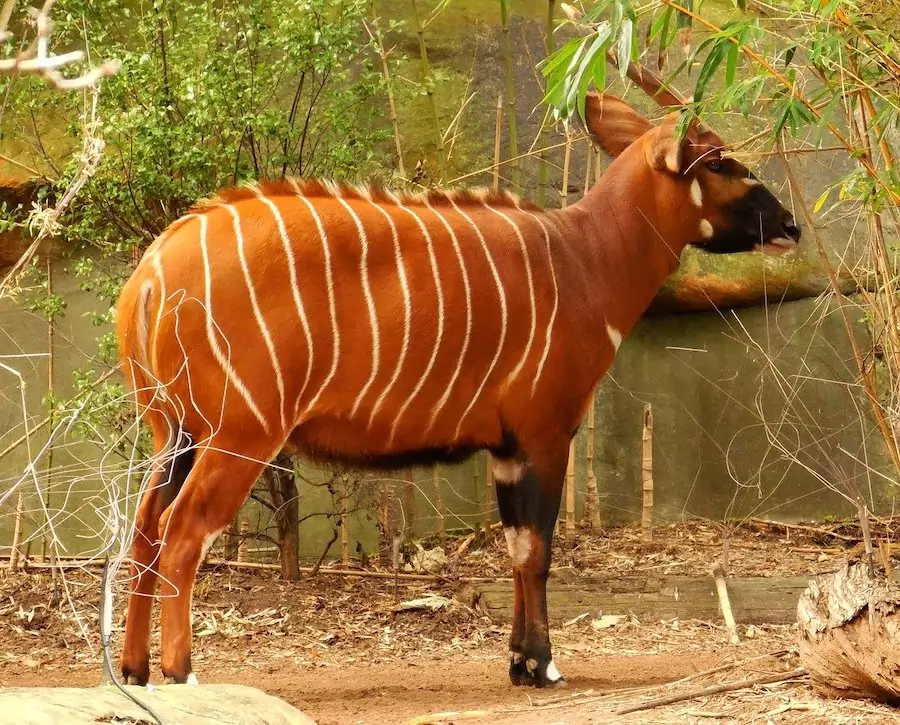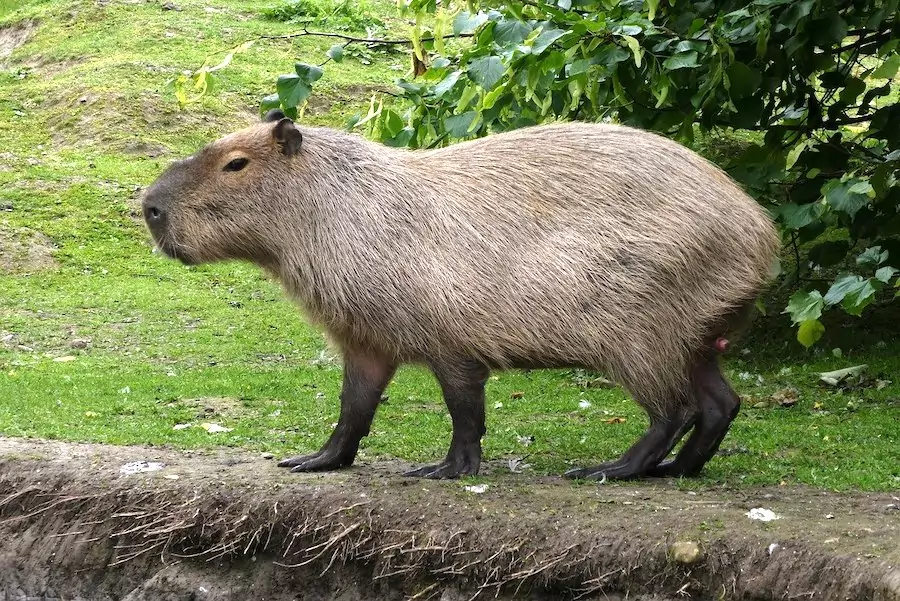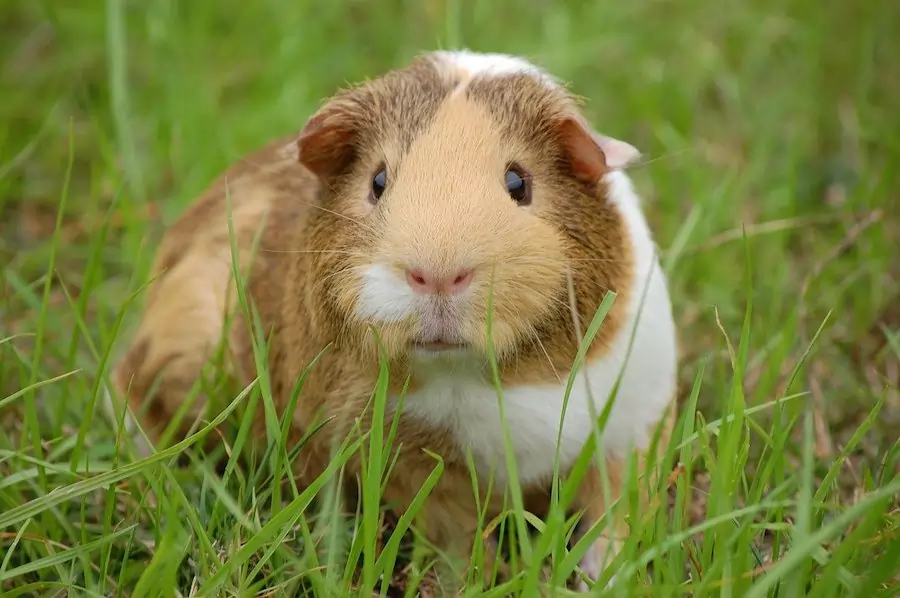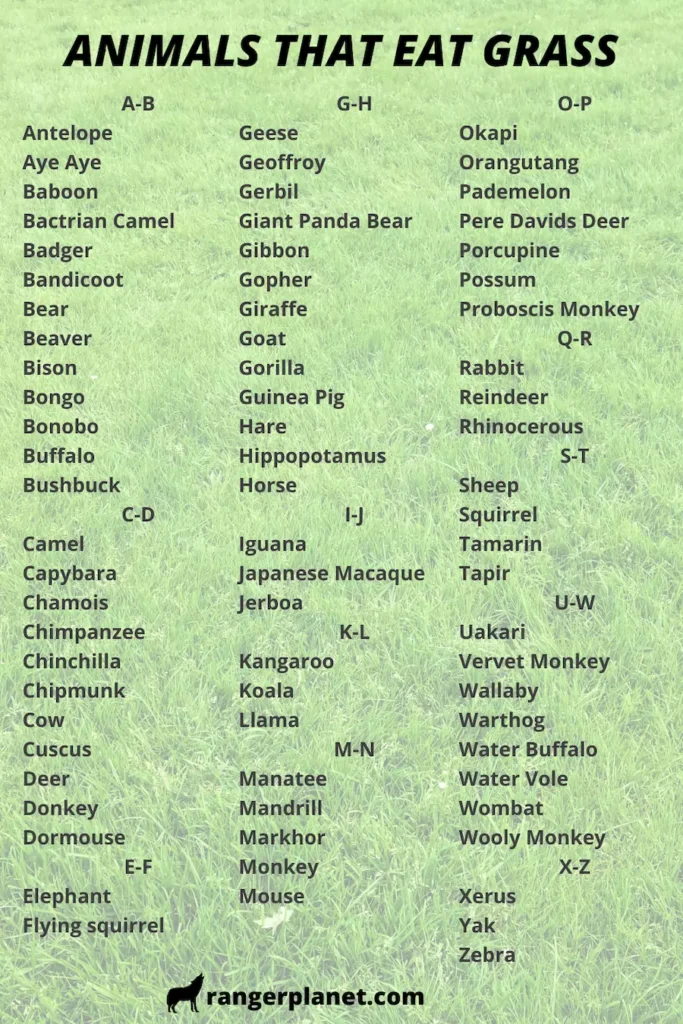So you wanted to know what eats grass? Well, here it is, the enormous A-Z list of everything that eats grass.
Animals that primarily feed on grass are known as granivores. But there are lots of animals that eat grass as part of their diet. Those that include leaves, twigs, and other plant parts are also referred to as “browsers”.
In fact, so many eat grass to some degree or other, that there will doubtless be some here that I’ve missed, but this will give you a broad overview to go on.
So sit back while I take you through all the animals that eat grass! Either through the Youtube Video below from the Ranger Planet Youtube Channel. Or you can continue reading down the list.
What eats grass A-B
Antelope
Antelopes tend to feed more on smaller bushes, or grass. What kind of grass they eat or in general what they eat depends on their height and mostly includes medium-length grass.
Aye Aye
A relatively small, long-fingered primate from Madagascar. The Aye-Aye has a seed-rich diet and prefers to eat seeds more than grass. Apart from these, nectar, flowers, fruits, bark, cankers, and cultivated crops also make a part of their diet.
Baboon
Baboons are opportunistic eaters and will eat grass whenever they need to or when circumstances mean there is nothing else currently available.
Bactrian Camel
As herbivores that have tough lips designed to eat very hard vegetation, camels eat grass and often prefer salty varieties.
Badger
Badgers are omnivores. They prefer to forage for earthworms, grubs, insects, and larvae. But will also eat grass, preferably short succulent grasses, as well as flower bulbs, fruits, and vegetables.
Bandicoot
Bandicoots are native to Australia and New Guinea and are small marsupials.
They are omnivores, so they eat both plants and animals. They primarily feed on insects like ants spiders, worms, and beetles found mostly in leaf litter. As plant eaters, they will occasionally feed on grass and small shoots.
Bear
Bears are primarily carnivores but do include grasses regularly in their diet, along with other early vegetations in the spring. Find out what could possibly eat a bear.
Beaver
Beavers are vegetarians, and their diet alters through the seasons. Their spring and summer diet mostly consists of non-woody plant matter such as lilies, herbs, algae, and indeed grasses. In fall and winter, they seek out twigs, bark, inner bark, and roots.
Beavers shift from a woody diet to a herbaceous diet as new growth appears in the spring. Find out the nocturnal habits of Beavers.
Bison
Although bison mainly graze on mixed-grasses commonly found in prairies. As general foragers, they eat a variety of herbaceous grasses and sedges. But they will also eat woody vegetation depending on the habitat, and when food is in limited supply.
Bongo
A bongo is a nocturnal forest ungulate. They’re considered to be herbivorous browsers, feeding mainly on leaves, grasses, bushes, and vines. Plus occasionally the pith of rotting trees. Bongos have been known to eat burnt wood after forest fires because they contain a source of salt and minerals.
Bonobo
Also known as the pygmy chimpanzee, has a main diet consisting of leaf stems, fruits, and types of insects and fish. But their diet also includes vegetation, such as herbs and roots.
Buffalo
Buffalos are herbivores ad so they eat only vegetation. Their preferred food is grass, followed by herbs. They also find aquatic plants palatable when feeding around water sources.
Bushbuck
As herbivores, bushbucks graze on grass for the majority of their feeding time during the day. As well as different types of leguminous herbs, shrubs, leaves, twigs, tree bark, flowers and even fallen fruit. Grass forms a major part of their diet.

What eats grass C-D
Camel
Camels are diurnal creatures, and as such spend most of their day feeding on a variety of vegetation, this includes grass, including straw, grains, and a variety of leaves, branches, and bushes. They can even eat shorter grasses due to the split structure of their upper lips.
Capybara
The capybara is a large rodent native to South America. Visually close in appearance to beavers. they are the largest known rodent to exist.
Capybaras are herbivores. Their diet consists largely of vegetation and aquatic plants alongside water sources. eating their own poop provides bacteria that facilitate the digestion of plant matter. During the dry season, when fresh grasses and water plants are in short supply, they opt to eat reeds, grains, melons, and squashes.
An adult capybara can eat between 6 to 8 lbs. (2.7 to 3.6 kg) of fresh grass per day. During the dry season, when fresh grasses and water plants dry up, they opt to eat reeds, grains, melons, and squashes.
Chamois
Chamois have a herbivorous based diet. Mainly feeding on a variety of grasses, herbs, and flowers throughout the summer season. In winter they turn to mosses, lichens, barks, pine shoots, and even pine needles. They prefer to feed in sub-alpine areas close to forests and prefer highland grasses.
Chimpanzee
Chimpanzees are omnivores, they will look to eat a number of edible plants and meat-based food. this includes grasses on occasion, but nuts, fruit, mushrooms, flowers, and leaves, as well as insects, make up the bulk of their diet.
Chinchilla
Chinchillas are actually omnivores, so they will eat plant and meat-based foods. But the primary element of their diet includes grasses. Mainly all types of dried grasses and hay.
Chipmunk
Chipmunks commonly eat grasses, nutritional shoots, and other plant matter for a wide array of added benefits. They are omnivorous, so aside from grass, they will also feed on nuts, seasonal fruit, buds, and even fungi. They also eat small frogs, worms, insects, arthropods, and even birds’ eggs.
Cow
Known as “ruminants”, cows have a large stomach ideal for large quantities of grass. As herbivores, cows will consume about 2.5%-3% of their body weight of grass per day. On average, a 1,000-pound cow is likely to eat 25-30 pounds of grass and legumes a day. Cows are true granivores.
This answer would include most types of cattle (or bovine) such as highland cattle or zebu.
Cuscus
A cuscus is a large possum that dwells in tropical forests and is primarily native to New Guinea.
Cuscus’ are omnivores, but they have a mainly herbivorous diet. Feeding on grasses, fruits, leaves, and flowers. They are omnivorous because they will also feed on eggs, small birds, and reptiles depending on the season and their habitat.
Deer
Grasses are not a deer’s primary or preferred choice of nutritional food and is not a necessity in their diet. But deer will feed on vines, twigs, and shoots, leaves, and other woody plant matter, as well as weeds. Their grass preference is for young nutritional shoots.
I deers diet could also include meat. And you can find out where deer sleep in the wild.
I’d also add elk and moose into this heading too. Find out the difference between an elk and a moose. Plus what a moose eats here.
Donkey
Depending on seasonal variances and habitat availability, donkeys don’t only exist on grass and hay. They widen their diet to include small trees, bushes, woody shrubs, broadleaf weeds, and plants, all summarized as “browse”.
Donkeys require around 1.5-1.8% of their body weight in dry matter (or browse) per day. That’s the total amount of dry matter in the grass. This category could also include mules.
Dormouse
The dormouse has a varied diet which also includes grass. But how often or when do they prefer to eat grass is unknown and is believed to make up only a small element of their overall diet.
Here’s everything you need to know about the Dormouse, which includes food and its habitat.

What eats grass E-F
Elephant
Elephants are herbivores, so they feed on plant matter only. They consume a wide variety of plants in the wild and on the plains of the savannah. This includes grasses, herbs, shrubs, fruit, woody trees, and even bark.
A typical adult elephant can eat up to a huge 660 lb, (300 kgs) per day!
Flying squirrel
When flying squirrels emerge from their drey after winter hibernation, they will look to feed on any new spring nutritional food, such as new grasses, herbs, seeds, flowers, legumes, and other vegetables, and other nutrients. They are omnivores, so will seek out insects, and worms too.
What eats grass G-H
Geese
Geese will eat grass, they also eat other plant matter like shoots, stems, roots, grain, berries, and bulbs. As omnivores, they also eat insects they find in grass and shrubs. Canada Geese can also submerge and so will feed on small fish.
Geoffroy
Geoffroy’s cat is a small feline wild cat native to the southern regions of central South America. Small vertebrates make up to 99% of a Geoffroy cat’s diet, and the rest includes grass, fruits, flowers, and nectar.
Gerbil
Gerbils eat a variety of grasses including dried grass and hay. But gerbils relish seed and grain.
Giant panda bear
A giant panda’s diet mainly consists of bamboo and mostly young tender bamboo shoots. But bamboo is a type of fast-growing grass.
Gibbon
Gibbon monkeys are omnivores, so they will eat both plant and meat-based foods. They mostly eat fruit, leaves, and insects found in the canopies of the rainforest. But when food is scarce they will turn towards eating grass to substitute their diet, however, this is rare.
Gopher
They only occasionally graze for grasses.
Giraffe
Giraffes are herbivores and will eat grass. But the proportion of grass in their diet is very low. As browsers, they mainly feed on leaves, buds, and twigs on trees, as well as shrubs. Find out if Lions eat giraffes.
Goat
Goats aren’t picky and will eat just about any type of grass they can find. A mixture of grasses is perfect for a wild goat to meet its dietary needs.
Gorilla
The majority of a gorilla’s diet is fruit. While they can survive on vegetations and grasses, they provide low nutritional quality.
Guinea pig
Guinea pigs naturally graze, eating only grass and hay, herbs, and some broad leaves and shrubs. They spend their time eating for long periods both day and night. This makes them a true granivore.
Hare
Hares are herbivores. In the wild hares will mainly consume a variety of grasses. In fact, 80-85% of a hare’s diet makes up grass and herbs. The remainder of their diet consists of foods found more readily during winters, such as buds, twigs, winter field crops, and even tree bark.
Hippopotamus
Hippos are herbivores and feed on plant matter only. Short grasses commonly found on savannahs and alongside water sources predominantly make up their diet. This is the food they share with other herbivores like buffaloes and zebras. They will occasionally eat fruits to supplement their diet, but this is rare.
Horse
Absolutely, In fact, the natural diet of all types of horses is grass found in pastures, as well as tender plants and brod leaves weeds. They do eat hay and dried grass as well. A well-watered pasture contains all the nutrition a horse requires to be fit and healthy.

What eats grass I-J
Iguana
Iguanas are primarily folivores, meaning they eat plants; specifically, they eat leaves. In the wild, iguanas feed almost entirely on the leaves of trees and vines, plus some fruits and flowers. As a by-product, they will consume grasses among this foliage.
Japanese Macaque
Also called snow monkeys, they dwell in the far north of mainland Japan. Their primary diet consists of leaves and shrubs found in tropical rainforests. As a byproduct of eating plant matter, they will occasionally consume grass.
Jerboa
Jerboa is a small, hopping desert rodent found throughout North Africa and Asia, Their primary diet consists of grasses, seeds, and roots. The Baluchistan pygmy Jerboa is known to burrow underbrush and shrubs to find and eat leaves and wind-blown seeds blown beneath the bushes.
What eats grass K-L
Kangaroo
Kangaroos are true herbivores, so they eat only plant matter, primarily, kangaroos feed on grasses but will consume other plants. They mostly graze at night. Baby kangaroos will start with their mother’s milk and transition to eating grasses.
Koala
An adult koala eats between 200 to 500 grams of leaves each day. They eat mainly eucalyptus leaves (gum leaves) and opt for grasses on some occasions.
Find out how dangerous koalas are!
Llama
Llamas, similar to cows, will graze only on grass. Pasture-type grass is ideal for their nutritional needs. However, their diet does widen when seasons and habitats require it to. So they can survive on a variety of plants and hay, and obtain all their water requirements from grass and plant matter.
A llama can consume approximately two pounds of grass for every 125 pounds of body weight per day.
What eats grass M-N
Manatee
These fully aquatic herbivores share the name of manatee grass which they graze on. But they do feed on a wide variety of submerged, shoreline, and floating vegetation. Up to 60 species of plant matter, including turtle grass, mangrove leaves, shoal grass, algae, water hyacinth, acorns, and hydrilla
Manatees are large herbivores and can eat a tenth of their own weight in just 24 hours.
Mandrill
These monkeys dwell primarily on the ground. They are omnivores but primarily feed as herbivores. They eat grass and fungi, and fruit, and also dig for seeds, and roots. Mandrills will also eat insects and small vertebrates.
Markhor
A large, wild goat found in central and western Asia, markhors are folivores and herbivores. They commonly eat grass, shoots, and leaves found at ground level and in small trees, bushes, and shrubs. Grass, however, is their primary food source.
Monkey
I’ve mentioned some specific monkey breeds in this list, but monkeys, in general, eat leaves, fruits, and grasses and are the last surviving species in what was once a long list of numerous terrestrial, grass-eating primates.
Mouse
Strangely, mice occasionally eat grass when they need to or when food is scarce.
You might also like to know what eats a mouse. So here’s the list of mice predators.

What eats grass O-P
Okapi
Known also as the forest giraffe. As omnivores, they mainly prefer to eat bamboo. Bamboo is considered a fast-growing type of grass. But they do also eat fruit, mushrooms, insects, and even eggs, birds, and fish as part of their wider diet.
Orangutang
On average, 90% of orangutans’ food intake is composed of fruits. Grasses make up just a small part of their diet.
Pademelon
Pademelons are small marsupials found in Australia and New Guinea. As herbivores, these mainly feed on grasses and herbs, but also eat leaves, shoots, berries, mosses, and ferns. They have also been observed eating tree bark and young tree matter.
Pere davids deer
They eat grass and can be choosy on the types of grass they eat. During winter, when the grass is often in short supply they gravitate towards eating aquatic plants around water sources, searching for shrubs in and around marshland areas.
Porcupine
As herbivores, porcupines primarily eat vegetation. Often this includes wood, bark, and stems. Porcupines also eat nuts, seeds, grass, tubers, buds, and fallen fruit. They eat grass mostly in spring and summer and tree-based matter in the winter months.
Possum
Grasses are not typically a part of an opossum’s diet but do they do tend to nibble on a little when they dig up lawns as they search for worms and grubs.
Probosci’s monkey
Probosci’s monkeys are seasonal folivore/frugivores. They occasionally feed on insects, such as grubs and caterpillars. Plant matter they consume includes a variety of fruit and berries, seeds, nutrient-rich shoots and leaves, and occasionally grass too.
What eats grass Q-R
Rabbit
Rabbits are renowned for eating a lot of grass. So much so they can eat it down to the crown, which can actually damage areas of grass through constant rabbit grazing. Fencing off, and maintaining healthy lawns can help reduce this impact.
Reindeer
An average adult reindeer eats 9 to 18 pounds of vegetation a day. This includes grass, herbs, mosses, ferns, shoots, and leaves of shrubs and trees such as birch and willow. During winter this changes to hoof-digging for lichen, known as reindeer moss, and fungi.
Rhinoceros
Rhinos are considered herbivores, and “browsers” so most of their sustenance comes from eating trees and bushes. Grass can form up to 40% of their diet. They will snatch clumps of grass, or pluck at leaves, fruits, twigs, and small branches from shrubs and trees. Both white and black rhinos graze on grasses.
What eats grass S-T
Sheep
As natural grazers, sheep spend their time eating pasture grass, clover, and small soft shrubs. On average, sheep eat around 4% of their own weight in grass per day, around 2-3 lb. They prefer short grasses and can survive on grass alone. Beyond their mother’s milk, lambs will feed on grass too.
Find out how sheep survive in the wild.
Squirrel
Squirrels will eat grass on occasion. However, they prefer acorns, nuts, seeds, berries, bugs, and will occasionally eat birds and birds’ eggs. They will eat fresh grass, but much prefer grass seeds over grass.
Find out the full list of what squirrels eat here.
Tamarin
These small-sized primates are found in South America. They primarily eat fruit and are also said to eat grass on some occasions
The pied tamarin is an omnivore, their diet is rich in insects, small rodents, reptiles, and eggs but also includes grass as a small portion. For cotton top tamarins, grass, fruits, and insects make up the majority of their diet. They forage through the middle layer of the canopy for food. While Emperor Tamarin eats grass occasionally.
Tapir
A tapir is a nocturnal hoofed mammal with a short thick body, thickset limbs, and a short flexible snout. Similar in appearance to a pig, but are in fact more closely related to rhinos and horses, tapir are native animals to the tropical forests of Central, and South America, and Malaysia
As herbivores, they also tend to include grass as part of their diet. They consume between 7 to 8 pounds of vegetation per day. But are considered browsers, so will feed on grass, leaves, twigs, and fruits from shrubs and trees

What eats grass U-W
Uakari
As a type of monkey, and as omnivores, they eat seeds and fruits that make up a vast majority of their diet, and on certain occasions, they include grasses in their diet too.
Vervet Monkey
Vervet monkeys are generally omnivores and grazers. Preferring grasses, leaves, seeds, buds, young shoots, nuts, fruit and berries, fungi and flowers, and tree gum. But are also known to occasionally eat vertebrates and invertebrates, such as birds, birds’ eggs, small reptiles, and rodents.
Wallaby
As herbivores, wallabies predominantly eat grasses, plants, and shrubbery. Their large flat teeth and long snouts are perfect for grinding and chewing grass and plant matter.
Warthog
Warthogs may be aggressive at times, but invariably they are grazers and browsers, mostly feeding on grasses, plants, and small shrubbery. They also use their extended and tough snouts to dig surface soil for bulbs and nutritious root material
Water buffalo
Water buffalo are herbivores. As grazers and browsers, they forage for plant matter. They mostly prefer and eat grasses, but also feed on fruit, shrubs, bark, and other low-hanging plant material and foliage. Mostly, they favor grazing in open grassland for grasses and herbs.
Water vole
Water Voles are omnivores, but mostly herbivores. They feed on grasses growing along riverbanks and on aquatic plants in slow-moving water. While they eat grasses they mainly prefer to feed on young grass shoots.
Wombat
As complete herbivores, wombats graze for up to 8 hours each night native grasses such as the tussocky (snow grass), spear grass, kangaroo grass, wallaby grass, and poa grass. They will also eat stems and roots of shrubs and trees.
Woolly Monkey
As a frugivorous species, the woolly monkey includes grasses only as a small portion of their diet, and that too under special circumstances when their preferred food of fruits and leaves are in short supply.
What eats grass X-Z
Xerus
These animals, also called African ground squirrels, are mostly herbivores and do eat grasses. But, seeds nuts, and roots make up a major portion of their diet.
Yak
As ruminant grazers, yaks migrate seasonally to the lower plains to seek out and feed on grasses and herbs. When the weather warms, they move to higher ground to feed on mosses and lichens.
Zebra
As herbivores, zebra spend most of their time moving to fresh grasslands to feed on grass and locate water sources But they are also browsers, which means they will feed on leaves, twigs, shrubs, and bark. When the weather is dry, they will eat dry and coarse grasses.
More help beyond what eats grass
So there you have it, the long list of animals that eat grass. Be sure to check out other articles on the ranger planet website. Or visit our Ranger Planet YouTube channel for lots of interesting animal facts videos.

